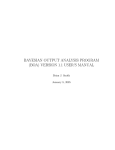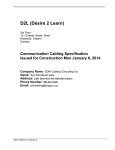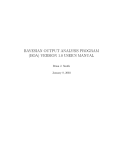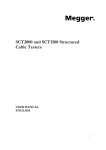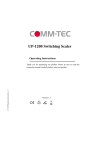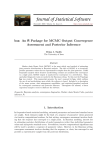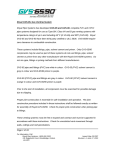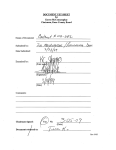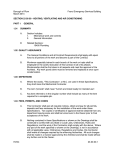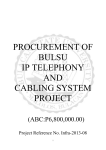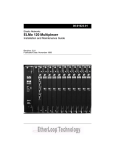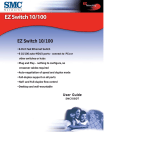Download Cable specifications - City of Port St. Lucie
Transcript
Category 6A System City of Port St Lucie IT Specification May 2014 Rev 3.1 Preface The specified system is an unshielded balanced twisted-pair cabling system designed for 10 Gb/s networking environments. Typical deployments include data centers, commercial buildings, and institutional sites (e.g., health care, education, military). Category 6A System Bid Specification - City of Port St. Lucie Page 3 Acronyms AHJ Authority having jurisdiction ANEXT Alien near-end crosstalk ANSI American National Standards Institute ASTM LC Limited combustible LSOH Low smoke zero halogen LSZH Low smoke zero halogen American Society for Testing and Materials m Meter(s) MHz Megahertz AWG American wire gauge mm Millimeter(s) BICSI Building Industry Consulting Service International N Newton(s) NEXT Near-end crosstalk C Celsius nF Nanofarad(s) CDT Cable Design Technologies ns Nanosecond(s) CMP Communications plenum NVP Nominal velocity of propagation CMR Communications riser OD Outside diameter CP Consolidation point PCB Printed circuit board CSC Construction Specifications Canada PE Professional Engineer CSI The Construction Specifications Institute pF Picofarad(s) CSV Certified System Vendor PSACRF Power-sum attenuation-to-crosstalk ratio far-end dB Decibel(s) PSAACRF DC Direct current Power-sum attenuation-to-alien crosstalk ratio far-end EF Entrance facility PSANEXT Power-sum alien near-end crosstalk EIA Electronic Industries Alliance ELFEXT Equal level far-end crosstalk PSELFEXT Power-sum equal level far-end crosstalk ER Equipment room PSNEXT Power-sum near-end crosstalk F Fahrenheit RFQ Request for quote ft Foot/feet TBB Telecommunications bonding backbone Gb/s Gigabits per second TDR Time domain reflectometer IBDN Integrated Building Distribution Network TE Telecommunications enclosure IDC Insulation displacement contact TGB Telecommunications grounding busbar IEC International Electrotechnical Commission TIA Telecommunications Industry Association IEEE Institute of Electrical and Electronics Engineers TMGB Telecommunications main grounding busbar in Inch(es) TO ISO International Organization for Standardization Telecommunications outlet/connector TR Telecommunications room kg Kilogram(s) U Rack unit [45 mm (1.75 in)] lb Pound(s) UL Underwriters Laboratories lbf Pound-force WA Work area Table of Contents DIVISION 27 – COMMUNICATIONS......................................................................................... 1 27 00 00 COMMUNICATIONS ........................................................................................... 1 27 05 00 COMMON WORK RESULTS FOR COMMUNICATIONS .................................. 1 27 05 26 Grounding and Bonding for Communications Systems................................... 1 27 05 28 Pathways for Communications Systems ......................................................... 2 27 05 53 Identification for Communications Systems..................................................... 2 27 08 00 COMMISSIONING OF COMMUNICATIONS...................................................... 3 27 08 01 System Documentation.................................................................................... 3 27 08 02 Test Results Documentation............................................................................ 3 27 08 03 As-Built Drawings ............................................................................................ 4 27 10 00 STRUCTURED CABLING................................................................................... 5 27 10 01 Scope............................................................................................................... 5 27 10 02 Regulatory References .................................................................................... 5 27 10 03 General Condition – Approved Vendor............................................................ 7 27 10 04 General Condition – Approved Installer........................................................... 7 27 10 05 General Condition – Approved Products ......................................................... 8 27 10 07 Work Included .................................................................................................. 8 27 10 08 Drawings Specifications................................................................................... 9 27 10 09 Pre-Project Submittals ................................................................................... 10 27 10 10 Delivery, Storage, and Handling .................................................................... 10 27 10 11 Structured Cabling Overview ......................................................................... 11 27 10 13 Warranty and Services .................................................................................. 13 27 11 00 COMMUNICATIONS EQUIPMENT ROOM FITTINGS..................................... 15 27 11 13 Communications Entrance Protection ........................................................... 15 27 11 16 Communications Cabinets, Racks, Frames, and Enclosures ....................... 15 27 11 19 Communications Termination Blocks and Patch Panels............................... 16 27 13 00 27 13 13 27 15 00 COMMUNICATIONS BACKBONE CABLING.................................................. 18 Communications Copper Backbone Cabling................................................. 18 COMMUNICATIONS HORIZONTAL CABLING............................................... 19 27 15 13 Communications Copper Horizontal Cabling................................................. 19 27 15 43 Communications Faceplates and Connectors............................................... 21 27 16 00 27 16 19 COMMUNICATIONS CONNECTING CORDS, DEVICES, AND ADAPTERS. 25 Communications Patch Cords, Station Cords, and Cross-Connect Wire ..... 25 ANNEX A: ADDITIONAL INFORMATION .............................................................................. 26 DIVISION 07 – THERMAL AND MOISTURE PROTECTION ................................................. 26 07 80 00 FIRE AND SMOKE PROTECTION................................................................... 26 07 84 00 FIRESTOPPING ................................................................................................ 26 07 84 13 Penetration Firestopping................................................................................ 26 DIVISION 27 – COMMUNICATIONS 27 00 00 Communications 27 05 00 Common Work Results for Communications 27 05 26 Grounding and Bonding for Communications Systems NOTE: If grounding and bonding does not need to be specified, remove Section 27 05 26. 27 05 26.01 GENERAL 27 05 26.01.A The facility shall be equipped with a telecommunications bonding backbone (TBB). This backbone shall be used to ground all telecommunications cable shields, racks, cabinets, raceways, and other associated hardware that has the potential to act as a current-carrying conductor. The TBB shall be installed independent of the building’s electrical and building ground and shall be designed in accordance with the recommendations found in ANSI-J-STD-607-A, Commercial Building Grounding (Earthing) and Bonding Requirements for Telecommunications. 27 05 26.01.B The main entrance facility/equipment room (EF/ER) in each building shall be equipped with a telecommunications main grounding busbar (TMGB). Each telecommunications enclosure (TE) and/or telecommunications room (TR) shall be provided with a telecommunications grounding busbar (TGB). The TMGB shall be connected to the building electrical entrance grounding facility. The intent is to provide a telecommunications grounding system that is equal in potential to the building electrical grounding system. This will minimize ground loop current potential between telecommunications equipment and the electrical system that supplies power to the equipment. 27 05 26.01.C All metal equipment racks, cabinets, backboards, cable shields, strength members, splice cases, cable trays, and the like entering or residing in TEs/TRs/ERs/EFs shall be grounded to the appropriate TGB/TMGB using a minimum 6 AWG stranded copper bonding conductor and compression connectors. Category 6A System Bid Specification – City of Port St. Lucie Rev 3.1 May 2014 Page 1 27 05 26.01.D All wires used for telecommunications grounding purposes shall be identified with green insulation or green tape. Non-insulated wires shall be identified at each termination point using green tape. All cables and busbars shall be identified and labeled in accordance with ANSI-J-STD607-A. 27 05 26.02 GROUNDING AND BONDING SYSTEM INSTALLATION 27 05 26.02.A The TBB shall be designed and/or approved by a qualified Professional Engineer (PE), licensed in the jurisdiction where the work is to be performed. The TBB shall adhere to the recommendations found in ANSI-J-STD-607-A and shall be installed in accordance with industry best practices. 27 05 26.02.B A licensed electrical contractor shall perform the installation and termination of the main bonding conductor to the building service entrance ground. 27 05 28 Pathways for Communications Systems NOTE: If a design for pathways is to be specified, add appropriate wording to the following sections. Otherwise, delete Section 27 05 28. 27 05 28.29 HANGERS AND SUPPORTS FOR COMMUNICATIONS SYSTEMS 27 05 28.33 CONDUITS AND BACKBOXES FOR COMMUNICATIONS SYSTEMS 27 05 28.36 CABLE TRAYS FOR COMMUNICATIONS SYSTEMS 27 05 28.39 SURFACE RACEWAYS FOR COMMUNICATIONS SYSTEMS 27 05 53 Identification for Communications Systems 27 05 53.01 GENERAL 27 05 53.01.A Labeling shall be in accordance with the recommendations found in TIA/EIA-606-A, the manufacturer’s recommendations/installation guides, and industry best practices. May 2014 Page 2 Category 6A System Bid Specification – City of Port St. Lucie Rev 3.1 27 08 00 Commissioning of Communications 27 08 01 System Documentation 27 08 01.01 GENERAL 27 08 01.01.A Upon completion of the installation, the successful bidder shall provide three comprehensive sets of documentation to the owner of the System for approval. Documentation shall include the items detailed below. 27 08 01.01.B Documentation shall be submitted within 10 working days of the completion of each testing phase (e.g., subsystem, area, floor). This includes all test results and draft as-built drawings. Draft drawings may include hand-written annotations. Printer-generated (final) copies of all drawings shall be submitted within 30 working days of the completion of each testing phase. The successful bidder shall provide copies of the original test results in electronic format, for example a Fluke Networks (*.flw) Linkware file or a Microsoft Excel (*.xls) file. 27 08 01.01.C The City of Port St. Lucie may request a 10% random field re-test of the installed cabling system (at no additional cost) to verify documented findings. If the re-test findings contradict the documentation submitted by the successful bidder, additional testing can be requested to the extent deemed necessary by the owner of the System, including a 100% re-test. This testing shall be at no additional cost to the owner of the System. 27 08 02 Test Results Documentation 27 08 02.01 GENERAL 27 08 02.01.A The test equipment shall meet the requirements found in ANSI/TIA-568B.2-10-2008 – Transmission Performance Specifications for 4-pair 100 Ω Augmented Category 6 Cabling. Category 6A System Bid Specification – City of Port St. Lucie Rev 3.1 May 2014 Page 3 27 08 02.01.B Test documentation shall be provided on permanent media within three weeks after the completion of the project. The media shall be clearly marked on the outside front cover with the words “Project Test Documentation”, the project name, and the date of completion (month and year). The results shall include a record of test frequencies, cable type, conductor pair and cable (or connector) ID, measurement direction, reference setup, and technician name(s). The test equipment name, manufacturer, model number, serial number, software version, and last calibration date will also be provided. Unless the manufacturer specifies a more frequent calibration cycle, proof of annual calibration must be documented for all test equipment used in this installation. 27 08 02.01.C Printouts generated for each cable by the test equipment shall be submitted as part of the documentation package. Alternately, the successful bidder may furnish this information in electronic format on permanent media. The media shall contain the electronic equivalent of the test results as defined by the bid specification, in a file format compatible with Microsoft Word (version 6.0) or Microsoft Excel (2002 or later version). 27 08 02.01.D When repairs and re-tests are performed, the problem(s) found and the corrective action(s) taken shall be noted. Both the failed and passed test results shall be documented including test data at all frequency points and graphs. 27 08 03 As-Built Drawings 27 08 03.01 GENERAL 27 08 03.01.A Drawings must include cable routes and telecommunications outlet/connector (TO) locations. Each TO location shall be referenced by its unique identifier. Numbering, icons, and drawing conventions used shall be consistent throughout all documentation provided. The owner of the System will provide floor plans in paper and electronic (DWG, AutoCAD Release 14) formats, to which as-built construction information can be added. These documents will be modified accordingly by the successful bidder to denote as-built information as defined above and returned to the owner of the System. 27 08 03.01.B The successful bidder shall annotate the base drawings and provide both print (same plot size as originals) and electronic (AutoCAD Release 14) versions of the modified files. May 2014 Page 4 Category 6A System Bid Specification – City of Port St. Lucie Rev 3.1 27 10 00 Structured Cabling 27 10 01 Scope 27 10 01.01 GENERAL 27 10 01.01.A This document describes the requirements for furnishing and installing a telecommunications cabling infrastructure for the City of Port St Lucie. A balanced twisted-pair cabling system capable of supporting 10 Gb/s networking is described. 27 10 01.01.B All cables and related support, termination, and grounding hardware shall be furnished, installed, tested, labeled, and documented by the successful bidder as detailed in this document. 27 10 01.01.C General product specifications, design considerations, and installation guidelines are provided in this document. Specific site-related requirements are provided as an attachment to this document. In case of conflict, this document shall take precedence. The successful bidder shall meet or exceed all requirements for the cabling system described in this document. 27 10 02 Regulatory References 27 10 02.01 GENERAL 27 10 02.01.A All workmanship and materials shall be in full conformance with applicable building, electrical, and other codes, as determined by the authority having jurisdiction (AHJ). 27 10 02.01.B All cabling system components shall be Underwriters Laboratories (UL) Listed and shall be marked as such. In cases where UL has no published standards for a component, any equivalent national independent testing standard shall apply and the item shall be appropriately marked. Where UL has an applicable system listing and label, the entire system shall be labeled. 27 10 02.02 REFERENCE LIST 27 10 02.02.A The product specifications, design considerations, and installation guidelines provided in this document are in part derived from recommendations found in recognized telecommunications industry standards. The following are used as reference: Category 6A System Bid Specification – City of Port St. Lucie Rev 3.1 May 2014 Page 5 1. Spaces and Pathways ISO/IEC 18010:2006 – Pathways and Spaces for Customer Premises Cabling TIA-569-B (2009) – Commercial Building Standard for Telecommunications Pathways and Spaces TIA-942 (2010) – Telecommunications Infrastructure Standard for Data Centers 2. Grounding ANSI-J-STD-607-A (2002) – Commercial Building Grounding (Earthing) and Bonding Requirements for Telecommunications 3. Cabling Systems ISO/IEC 11801 2nd Edition 12/07/07 Information Technology – Generic cabling for Customer Premises TIA-1152 (2009), Requirements for Field Test Instruments and Measurements for Balance Twisted-Pair Cabling TIA-568-C.0 (2009) and associated Addenda – Commercial Telecommunications Cabling for Customer Premises TIA-568-C.1 (2009) and associated Addenda – Commercial Building Telecommunications Cabling Standard, Part 1: General Requirements TIA-568-C.2 (2009) –Balanced Twisted-Pair Telecommunications Cabling and Components Standards TIA/EIA-862 (2008) – Building Automation Systems Cabling Standard for Commercial Buildings TIA/EIA-942 (2010) – Telecommunications Infrastructure Standard for Data Centers 4. Cabling Administration ISO/IEC 14763-1:2004 – Implementation and Operation of Customer Premises Cabling – Part 1: Administration TIA/EIA-606-A (2008) – Administration Standard for Commercial Telecommunications Infrastructure 5. Networking IEEE Standard 802.3an (2006) – 10GBASE-T (10 Gb/s Ethernet operations over balanced twisted-pair cabling) 6. Design BICSI Telecommunications Distribution Methods Manual (TDMM) – th 12 edition (2009) 7. Installation BICSI Information Transport Systems Installation Manual (ITSIM) – th 5 edition (2008) May 2014 Page 6 Category 6A System Bid Specification – City of Port St. Lucie Rev 3.1 27 10 02.02.B In cases where product specifications, design considerations, and installation guidelines provided in this document are in conflict with the references listed above, the more stringent requirements shall apply. All references listed above were current during development of this publication. The bidder is responsible for referencing to the most recent releases when developing bid proposals. 27 10 02.02.C This document does not take precedence over any code, either partially or wholly. 27 10 03 General Condition – Approved Vendor 27 10 03.01 GENERAL 27 10 03.01.A The bidder must be an authorized reseller/installer of the System. The bidder must have successfully completed all design and installation training provided by the manufacturer of the System. 27 10 03.01.B The bidder shall demonstrate proven expertise in the implementation of network cabling. Expertise can be illustrated through the inclusion of details of at least three projects involving the design and installation of a Category 6, or Augmented Category 6 (Category 6A) balanced twistedpair cabling system within the past two-year period. Names and contact information for each of the three projects shall be included. 27 10 03.01.C The successful bidder shall hereinafter be referred to as the Vendor. 27 10 03.01.D The Vendor shall accept complete responsibility for the design, installation, acceptance testing, and certification of the System. 27 10 03.01.E The Vendor shall provide proof of its current authorized reseller/installer status and shall deliver the final warranty for the installed System. 27 10 04 General Condition – Approved Installer 27 10 04.01 GENERAL 27 10 04.01.A The installation of the System shall be performed by direct employees of the Vendor. Category 6A System Bid Specification – City of Port St. Lucie Rev 3.1 May 2014 Page 7 27 10 04.01.B 27 10 05 All installation and testing shall be performed by an authorized reseller/installer and supervised by individuals qualified to install and test the System, in accordance with the manufacturer requirements. The supervisor(s) shall have successfully completed installation training provided by the manufacturer. General Condition – Approved Products 27 10 05.01 APPROVED PRODUCTS: ALL CONDITIONS MUST BE MET FOR APPROVAL 27 10 05.01.A Approved balanced twisted-pair cable: Category 6A rating, 23awg., Solid Bare Copper Conductors or Bonded Pair Conductors, Polyolefin Insulation or FEP Insulation, 4 twisted pairs, H-Spline Center Member, Ripcord, PVC or Flamarrest Jacket 27 10 05.01.B Approved connectors: Category 6A rated, RJ45, Keystone footprint, Flexible Printed Circuit Board with 50u inch Gold over Nickel front connection, Phosphor Bronze with Tin Plating over Nickel IDC Rear Connection, Plastic –UL94V-0 Connector Body, Plastic element to hold cable pairs at right angles, Insulation Displacement Contacts (IDC) at 90 degree angles to neighboring IDC, Front termination- mated connection with 750 cycle durability, Rear termination – IDC connection with 20 termination durability, Cable/Connector Retention – 15lbs., Connector/Hardware Retention – 20lbs., Plug/Connector Retention11.25lbs. 27 10 05.01.C Approved patch panels: TIA Category 6A, Titanium, Rear termination, XBar termination, ISO Class EA 27 10 05.01.D Approved cordage: Category 6A, 4-pair 23 AWG UTP, bonded-pair, transmission performance up to 625 MHz 27 10 05.02 EQUIVALENT PRODUCTS 27 10 05.02.A To qualify for final System warranty, only products made or approved by the manufacturer of the System shall be used to ensure the end-to-end performance of the System. 27 10 07 27 10 07.01 May 2014 Page 8 Work Included GENERAL Category 6A System Bid Specification – City of Port St. Lucie Rev 3.1 27 10 07.01.A The work included consists of all labor, equipment, products, and supplies required to design, install, test, and certify the System in compliance with project specifications. 27 10 07.01.B The work included consists of (but is not limited to) the following: 1. Pre-registration of project with the manufacturer of the System as necessary. 2. Furnishing and installation of a complete balanced twisted-pair telecommunications cabling infrastructure capable of supporting Gigabit networking. 3. Furnishing, installation of, and termination of all cabling runs. 4. Furnishing and installation of all TOs, patch panels, and cordage. 5. Furnishing and installation of all required cabinets and/or racks in TEs, TRs, and/or ERs. 6. Furnishing of any other material required to implement a complete system. 7. Testing all installed cabling runs and furnishing a summary report confirming the Pass status of each run. 8. Furnishing all test and labeling information in both electronic and paper formats. 9. Providing training and complete documentation, including the a User Manual, Application Guidelines, and as-built drawings. 27 10 08 Drawings Specifications 27 10 08.01 GENERAL 27 10 08.01.A All drawings and plans provided with this document are diagrammatic. They are included to show the scope of the project in order to assist in the development of bid documents. The Vendor shall make allowances in the bid proposals to cover the work required to comply with the intent of the drawings and plans. 27 10 08.01.B The Vendor shall verify all dimensions at the site and is responsible for their accuracy. 27 10 08.01.C Prior to submitting a bid, the Vendor shall indicate: Category 6A System Bid Specification – City of Port St. Lucie Rev 3.1 May 2014 Page 9 1. Any specified materials the Vendor believes to be inadequate. 2. Any necessary items of work omitted from the bid specification. 27 10 09 Pre-Project Submittals 27 10 09.01 GENERAL 27 10 09.01.A Under the provisions of this document and prior to the start of work, the Vendor shall: 1. Submit proof of authorized reseller/installer status of their company with the System manufacturer and the names of all individuals that will be performing the installation and testing to the owner of the System. 2. Submit details of all cabling system products to be used to the owner of the System. 27 10 09.01.B Work shall not be performed without the written approval of the submitted items by the owner of the System. 27 10 09.01.C The Vendor must obtain approval from the manufacturer and from the owner of the System for any substitution of submitted products. No substituted items shall be installed without written approval. 27 10 10 Delivery, Storage, and Handling 27 10 10.01 GENERAL 27 10 10.01.A Delivery and receipt of project materials shall be determined for each project. 27 10 10.01.B All cable to be used in the project shall be stored according to manufacturer’s recommendations. In addition, all cable must be stored in a protected area. If cable is stored outside, it must be covered with opaque plastic or canvas for protection from the elements, with adequate ventilation to prevent condensation. If air temperature at the cable storage location will be below 4.4 °C (40 °F), the cable shall be moved to a heated location [minimum 10 °C (50 °F)]. If necessary, cable shall be stored offsite at the Vendor’s expense. 27 10 10.01.C If the Vendor intends to provide a trailer on-site for the storage of project materials, prior approval must be obtained from the owner of the System. May 2014 Page 10 Category 6A System Bid Specification – City of Port St. Lucie Rev 3.1 27 10 11 Structured Cabling Overview 27 10 11.01 GENERAL 27 10 11.01.A The system chosen shall meet the following specifications: 1. The balanced twisted-pair cabling system shall be available in bonded pair and non-bonded pair configurations. 2. The balanced twisted-pair cabling system shall support 10 Gb/s networking and shall provide guaranteed performance up to 625 MHz for a worst-case 4-connector, 100 m (328 ft) channel. NOTE: 4-connector refers to one TO, one consolidation point (CP), and two cross-connect panels in a TE/TR/ER (one for horizontal cables and one for equipment pigtails). 27 10 11.01.B At a minimum, the balanced twisted-pair cabling system will exceed the key performance parameters for Augmented Category 6A found in TIA568-C.2 (2009) – Balanced Twisted-Pair Telecommunications Cabling and Components Standards over the specified frequency ranges by the values listed below. Parameter Insertion loss Worst Case Margin (1 – 500 MHz) Worst Case Margin (500 – 625 MHz) 3% Beyond Standard (*) Return loss 2.0 dB Beyond Standard (*) NEXT 2.5 dB Beyond Standard (*) PSNEXT 3.5 dB 1.5 dB(*) PSANEXT 2.0 dB 2.0 dB(*) 10.0 dB 8.0 dB(*) PSACRF PSAACRF Beyond Standard Beyond Standard (*) Note: The Margin is the additional headroom (in dB or %) compared to the minimum specified value for Category 6A at each frequency point over the specified frequency range. The Worst Case Margin is determined at the frequency where the measured data point is closest to the limit line. The Category 6A limit line equations are used to determine the Worst Case Margin over the frequency range from 500 MHz to 625 MHz. Category 6A System Bid Specification – City of Port St. Lucie Rev 3.1 May 2014 Page 11 NEXT = Near-end crosstalk PSACRF = Power-sum attenuation-to-crosstalk ratio far-end PSAACRF = Power-sum alien attenuation-to-crosstalk ratio far-end PSANEXT = Power-sum alien near-end crosstalk PSNEXT = Power-sum near-end crosstalk NOTE: The values listed above are characterized as “Margin” or “Guaranteed Headroom” beyond the performance specified in standards, and serve as additional assurance of the cabling system’s performance after installation and over its operational lifespan. (*) Value proposed or statement represent guaranteed margin against TIA-568-C.2 (2009) – Balanced Twisted-Pair Telecommunications Cabling and Components Standards extrapolated to 625MHz. 27 10 12 Testing and Acceptance 27 10 12.01 GENERAL 27 10 12.01.A All terminated cabling runs shall be 100% tested for defects in installation and to verify cabling system performance under installed conditions according to the requirements found in the TIA/EIA-568-C series of standards. All pairs in each installed cable shall be verified prior to system acceptance. Any defect in the cabling system installation, including (but not limited to) cables, connectors, patch panels, and cordage shall be repaired or replaced in order to ensure 100% usability of all installed runs. 27 10 12.02 COPPER CHANNEL TESTING 27 10 12.02.A All balanced twisted-pair cable links shall be tested for basic continuity and length, as indicated below. Additional testing shall be performed to verify compliance with Category 6A performance for the parameters listed in Section 27 10 11.01.B of this document. The extent of testing shall be in accordance with the end-customer's testing requirements, with 100% testing of permanent links for Insertion Loss, Return Loss, NEXT, PSNEXT and PSACRF. These tests are performed at the same time as the Continuity test using an automated tester, such as the Fluke DTX1800. 27 10 12.02.B Continuity – Each pair in every installed cabling run shall be tested using a test set that detects and identifies opens, shorts, polarity and pair reversals, crossed pairs, and split pairs. The results shall be recorded as Pass/Fail (as indicated by the test set) and referenced to the appropriate cable identification number and circuit/pair number. Any fault shall be corrected and the run re-tested prior to final acceptance. May 2014 Page 12 Category 6A System Bid Specification – City of Port St. Lucie Rev 3.1 27 10 12.02.C Length – Every installed cabling run shall be tested for installed length using a time domain reflectometer (TDR) device. The cable length shall not exceed 90 m (295 ft). The cable length shall be recorded, referencing the cable identification number and circuit/pair number. 27 10 12.03 CATEGORY 6A PERFORMANCE TESTING 27 10 12.03.A Category 6A performance testing shall be done according to the requirements of TIA-568-C.2 and TIA-1152. 27 10 12.03.B Additional testing parameters to verify compliance with System are listed in Section 27 10 11.01.B of this document. 27 10 12.03.C Of the parameters referenced in Section 27 10 12.01.A, 27 10 12.03.A and 27 10 12.03.B, it is understood that alien crosstalk parameters cannot be 100% tested using current field test equipment. Alien crosstalk of Category 6A permanent links or channels are intended to be met by design. For verification purposes, the number of permanent links or channels to be tested as “disturbed” or “victim” is 1% of the total number of permanent links or channels in the installation or 5, whichever is greater. 27 10 13 Warranty and Services 27 10 13.01 QUALIFICATION OF SYSTEM 27 10 13.01.A The installed System shall be covered by a certification and warranty, issued by the manufacturer and delivered by the Vendor. 27 10 13.01.B Telecommunications spaces and pathways in new buildings or in those buildings having undergone major renovations in the preceding three years should conform to the recommendations outlined in TIA-569-B. In cases of installation in restrictive spaces and pathways (where it is not possible to implement the standards-based recommendations), no cabling run shall exceed 90 m (295 ft) in length nor be installed in any manner that limits the performance of the System. 27 10 13.01.C The installed System shall conform to all applicable local building and electrical codes. 27 10 13.02 CERTIFICATION 27 10 13.02.A To qualify for System Certification, the System shall be designed, installed, and tested by an authorized reseller/installer partner of the manufacturer of the system. Category 6A System Bid Specification – City of Port St. Lucie Rev 3.1 May 2014 Page 13 27 10 13.02.B To qualify for System Certification, the installed cabling system shall fully comply with all relevant manufacturer design and applications guidelines, including any pre-approved deviations. 27 10 13.02.C To qualify for System Certification, only products made or approved by the System manufacturer shall be used to ensure the end-to-end performance of the System. 27 10 13.03 25-YEAR COMPONENT WARRANTY 27 10 13.03.A The System Certification shall provide a twenty-five (25) year warranty for all Manufacturer-built passive components used in the installed System. Defective and/or improperly installed products shall be replaced and/or reinstalled at no cost to the owner of the System. 27 10 13.04 LIFETIME APPLICATION ASSURANCE 27 10 13.04.A The System Certification shall provide the assurance that all present and future commercially available applications engineered for the performance level of the installed cabling system in accordance published standards will work for the lifetime of the certified System. 27 10 13.04.B Should the certified System fail to support the networking technologies designed to operate over it—at the time of cutover, during subsequent use, or after upgrading active network devices (e.g., migrating to Gigabit Ethernet switches from 100 Mb/s Ethernet switches)— the manufacturer and the Vendor shall take prompt corrective action. 27 10 13.05 OWNER RESPONSIBILITY 27 10 13.05.A The Vendor shall provide a User Manual to the owner of the System. This document describes essential system elements and specifies the owner’s responsibilities for maintaining the integrity of the installed cabling system over time. The User Manual contains guidelines for cabling system modifications (e.g., relocations, additions, changes to services), in addition to labeling and record-keeping maintenance requirements. 27 10 13.05.B The owner of the System accepts that the benefits offered by System Certification are revoked if non-approved products are introduced to the installed System. To regain System Certification in such cases, a Vendor must apply and validate all corrective modifications deemed necessary by the Manufacturer. May 2014 Page 14 Category 6A System Bid Specification – City of Port St. Lucie Rev 3.1 27 11 00 Communications Equipment Room Fittings 27 11 13 Communications Entrance Protection NOTE: If entrance protection does not need to be specified, remove Section 27 11 13. 27 11 13.01 COPPER CABLE PROTECTION UNITS 27 11 13.01.A All copper circuits shall be provided with an entrance cable protector panel for electrical protection. All building-to-building circuits shall be routed through this protector. The protector shall be equipped with a 6 AWG copper bonding conductor between the protector ground lug and the approved ground point. 27 11 16 Communications Cabinets, Racks, Frames, and Enclosures NOTE: If cabinets, racks, frames, and enclosures do not need to be specified, remove Section 27 11 16. 27 11 16.01 RACKS 27 11 16.01.A All racks shall provide cable management and support elements for cordage at the front of the rack. They shall also provide cable management, support, and protection elements for the cables and/or equipment pigtails placed along the legs of the rack. 27 11 16.01.B Any free-standing rack shall be a knock-down rack assembly equipped with two vertical and two universal channels. 27 11 16.02 RACK INSTALLATION 27 11 16.02.A Racks shall be securely attached to the concrete floor using a minimum 9.5 mm (0.375 in) hardware or as required by local codes. 27 11 16.02.B Racks shall be placed with a minimum of 914 mm (36 in) clearance from the walls on all sides of the rack. When mounted in a row, there shall be a minimum of 914 mm (36 in) clearance from the wall behind the racks, in front of the row of racks, and from the walls at the ends of the row. 27 11 16.02.C All racks shall be grounded to the TGB in accordance with Section 27 05 26 of this document. Category 6A System Bid Specification – City of Port St. Lucie Rev 3.1 May 2014 Page 15 NOTE: If grounding and bonding does not need to be specified, remove Section 27 11 16.02.C. 27 11 16.02.D Rack-mount fasteners not used for installing patch panels and other hardware shall be bagged and left with the rack upon completion of the installation. 27 11 16.02.E Rack-mount termination equipment shall be installed in accordance with the manufacturer’s recommendations and installation guides. 27 11 16.02.F Wall-mount termination equipment shall be installed on 1.2 m x 2.4 m x 19 mm (4 ft x 8 ft x 0.75 in) void-free plywood. The plywood shall be mounted 0.3 m (1 ft) above the finished floor. The plywood shall be painted with two coats of white, fire-retardant paint. 27 11 16.02.G Wall-mount termination equipment shall be installed in accordance with the manufacturer’s recommendations and installation guides. 27 11 19 Communications Termination Blocks and Patch Panels 27 11 19.03 PATCH PANELS 27 11 19.03.A The patch panel system shall provide a centralized termination, identification, and service assignment point for Category 6A cabling and cordage in TEs/TRs/ERs. 27 11 19.03.B The patch panels used to terminate the 4-pair balanced twisted-pair cable shall have the following characteristics: 1. The patch panels shall be available in 24-port 1U, 48-port 1U, 48-port 2U, and 72-port 2U configurations. 2. The cord management system for the patch panel shall not occupy additional rack space [i.e., zero (0) U]. 3. The patch panels shall be equipped with 24, 48, or 72 connectors. The connectors shall have the characteristics described in Section 27 15 43 03 of this document. 4. The transmission characteristics of the patch panels will be guaranteed to 625 MHz for all ports. May 2014 Page 16 Category 6A System Bid Specification – City of Port St. Lucie Rev 3.1 27 11 19.05 COPPER TERMINATION HARDWARE INSTALLATION 27 11 19.05.A Cables shall be dressed and terminated in accordance with standardsbased recommendations, the manufacturer’s recommendations/installation guides, and industry best practices. 27 11 19.05.B The twisted pairs shall be guided, positioned and secured at the connector termination point using a termination bar that locks the pairs in place to prevent untwisting of pairs into the cable when terminating the conductors. 27 11 19.05.C The termination bar holding the wires in place at the IDC termination shall withstand a tensile force of 20 lbs minimum applied to the cable without dislodging the IDC connection 27 11 19.05.D Cables shall be neatly bundled, dressed, and routed to their respective termination connectors. Each patch panel shall terminate a cable bundle separated and dressed back to the point of cable entrance into the equipment cabinet or rack. 27 11 19.05.E Each cable shall be clearly labeled on the cable jacket behind the patch panel at a location that can be viewed without removing the bundle support element(s). Labels obscured from view shall not be acceptable. Category 6A System Bid Specification – City of Port St. Lucie Rev 3.1 May 2014 Page 17 27 13 00 Communications Backbone Cabling 27 13 13 Communications Copper Backbone Cabling 27 13 13.01 BACKBONE CABLES 27 13 13.01.A The backbone cabling is the portion of the cabling system that links the termination fields in different TEs/TRs/ERs within a building (and between buildings in a campus environment). It is commonly installed between floors in a vertical orientation. 27 13 13.02 BACKBONE CABLE INSTALLATION 27 13 13.02.A Backbone cables shall be installed in accordance with standards-based recommendations, the manufacturer’s recommendations/installation guides, and industry best practices. 27 13 13.02.B A plastic or nylon pull cord with a minimum test rating of 90 kg (200 lb) shall be co-installed with the cable in any conduit. 27 13 13.02.C Where cables are routed using conduits, the backbone and horizontal cables shall be installed in separate conduits. 27 13 13.02.D Where cables are installed in an air return plenum, any non-plenum cable shall be installed in metallic conduit. 27 13 13.02.E Where backbone cables and horizontal cables are installed in a cable tray or wireway, backbone cables shall be installed first and segregated from the horizontal cables. 27 13 13.02.F All backbone cables shall be securely fastened to a wall of the TE/TR/ER served. 27 13 13.02.G Backbone cables spanning more than three floors shall be securely attached at the top of the cable run with a wire mesh grip as well as on alternating floors or as required by local codes. 27 13 13.02.H Vertical cable runs shall be supported by messenger strand, cable ladder, or any other method that provides adequate support for the weight of the cable. 27 13 13.02.I Large bundles of backbone cables and/or heavy cables shall be attached to support elements using metal clamps and/or metal banding. May 2014 Page 18 Category 6A System Bid Specification – City of Port St. Lucie Rev 3.1 27 15 00 Communications Horizontal Cabling 27 15 13 Communications Copper Horizontal Cabling 27 15 13.01 TOPOLOGY 27 15 13.01.A The horizontal cabling shall be installed using a star topology, typically extending from centralized TRs to individual TOs in work areas (WAs). 27 15 13.01.B The cabling system shall provide (A MINIMUM OF TWO) cabling runs to the TO in each WA. All runs will terminate in designated TEs/TRs/ERs. No run shall exceed 90 m (295 ft), as measured from the cable termination point at each end. An additional 10 m (33 ft) is allowed for cordage at both ends, for a maximum allowable end-to-end or channel length of 100 m (328 ft). 27 15 13.02 HORIZONTAL CABLES 27 15 13.02.A The 4-pair balanced twisted-pair cables shall be available in Bonded pair and non-Bonded pair configurations. The characteristics listed below shall apply to both configurations. 27 15 13.02.B The cables will be available in plenum (CMP), non-plenum (CMR), low smoke zero halogen (LSOH/LSZH), and limited combustible (LC) versions. The minimum recommended installation temperature shall be 5 °C (40 °F). The temperature rating shall be 60 °C (140 °F). 27 15 13.02.C The cables shall include a cross-web filler. . 27 15 13.02.D The cable conductors shall be 23 AWG solid copper. 27 15 13.02.E The effective cable OD shall be 6.0 mm (0.24 in) for CMR-rated cable and CMP-rated cable. The effective cable OD is the diameter of a six-aroundone cable bundle divided by 3. 27 15 13.02.F The minimum bend radius shall be 25 mm (1 in) for CMR-rated cable and CMP-rated cable. 27 15 13.02.G The transmission characteristics of the cable must meet or exceed .Augmented Category 6 requirements as per TIA-568-C.2-2009. Category 6A System Bid Specification – City of Port St. Lucie Rev 3.1 May 2014 Page 19 27 15 13.03 HORIZONTAL CABLE INSTALLATION 27 15 13.03.A Horizontal cables shall be installed in accordance with standards-based recommendations, the manufacturer’s recommendations/installation guides, and industry best practices. 27 15 13.03.B A plastic or nylon pull cord with a minimum test rating of 90 kg (200 lb) shall be co-installed with the cable in any conduit. 27 15 13.03.C Cable raceways shall not be filled greater than the TIA-569-B recommended maximum fill for the particular raceway type, or 40%. 27 15 13.03.D Cables shall be installed in continuous lengths from origin to destination. An exception is made for one CP in any cabling run. 27 15 13.03.E Where cables are installed in an air return plenum, any non-plenum cable shall be installed in metallic conduit. 27 15 13.03.F If CPs are used, they shall be placed in accessible locations and housed in suitable enclosures intended for that purpose. 27 15 13.03.G If a J-hook or trapeze system is used to support cable bundles, all horizontal cables shall be supported at every 1.2 m to 1.5 m (48 in to 60 in) intervals. It is recommended that the support surface is rounded without any sharp edges and at least 2 inches wide. At no point shall cable(s) rest on acoustic ceiling grids or panels. 27 15 13.03.H Horizontal cables shall be bundled in groups of no more than 50 cables. Cable bundle quantities in excess of 50 cables may cause deformation of the bottom cables within the bundles, which will degrade the performance of those cables. 27 15 13.03.I Cable shall be installed above fire-sprinkler systems and shall not be attached to such systems or any associated ancillary equipment or hardware. The cabling system and its associated pathways shall be installed so that they do not obscure any valves, fire alarm conduit(s), boxes, or other control devices. 27 15 13.03.J Cables shall not be attached to ceiling grid or lighting fixture wires. Where support for horizontal cable is required, the Vendor shall install appropriate carriers to support the cabling. 27 15 13.03.K Any cable damaged or exceeding recommended installation parameters during installation shall be replaced by the Vendor prior to final acceptance at no cost to the owner of the System. May 2014 Page 20 Category 6A System Bid Specification – City of Port St. Lucie Rev 3.1 27 15 13.03.L Cables shall be identified by a self-adhesive label in accordance with Section 27 05 53 of this document and TIA/EIA-606-A. The cable label shall be applied to the cable behind the faceplate, on a section of cable that can be accessed by removing the cover plate. 27 15 13.03.M Balanced twisted-pair cable shall be installed so that there are no bends smaller than 4 times the OD of the cable at any point in the run or at the termination points. 27 15 13.03.N The pulling tension on any 4-pair balanced twisted-pair cable shall not exceed 110 N (25 lbf). 27 15 13.04 10GX Pre-Terminated Cabling System 27 15 13.04.A Category 6A cabling shall be available as a factory-terminated solution to save time when deploying 10G cabling in data center applications. 27 15 13.04.B The Category 6A pre-terminated cabling system shall be easy to install in standard patch panels using the same port-count configurations (ideally retrofitable inside the same panels). 27 15 13.04.C The Category 6A cabling system shall be easy to repair without disrupting service on the other cables in the group. 27 15 13.04.D The Pre-terminated cable assemblies shall be well protected within a polymer sleeve to withstand abuse and be equipped with a pulling eye to facilitate cabling deployment. 27 15 13.04.E The connectors at the ends of the cable assemblies shall not exceed 1.4 inches in diameter (over pulling-eye) to facilitate fishing through cabinet openings. 27 15 43 Communications Faceplates and Connectors 27 15 43.01 GENERAL 27 15 43.01.A Each horizontal cable shall be terminated at its designated WA in a modular connector assembly using a keystone footprint module designed to snap into a faceplate. 27 15 43.01.B The WA modular connector assembly/faceplate shall accommodate: 1. A minimum of two cabling runs. Category 6A System Bid Specification – City of Port St. Lucie Rev 3.1 May 2014 Page 21 2. Blank fillers, to be installed in any outlet port in the faceplate that is not occupied by a modular connector assembly. 27 15 43.01.C Multiple WA outlets that are in close proximity on drawings (and not separated by physical barriers) may be combined in a single faceplate. The Vendor shall be responsible for determining the optimum compliant configuration. 27 15 43.01.D The same orientation and positioning of modular connector assemblies on faceplates shall be used throughout the project. Prior to installation, the Vendor shall submit the proposed configuration(s) for WA modular connector assemblies/faceplates for approval by the owner of the System. 27 15 43.01.E All WA outlets shall accommodate printed label strips for outlet identification purposes. Printed labels shall be permanent and shall comply with TIA/EIA-606-A. Handwritten labels shall not be accepted. 27 15 43.02 FACEPLATES 27 15 43.02.A The faceplate housing the modular connector assemblies shall provide a symmetrically centered appearance for the modules. 27 15 43.02.B The faceplate housing the modular connector assemblies shall have no visible mounting screws. 27 15 43.02.C The faceplate housing the modular connector assemblies shall have built-in labeling windows to facilitate outlet identification. 27 15 43.03 CONNECTORS 27 15 43.03.A The modular connector assemblies using keystone footprint modules to terminate the 4-pair balanced twisted-pair cable shall have the characteristics listed below. 27 15 43.03.B The connectors shall be modular in form, with available mounting options for TOs, CPs, rack-mount panels, and wall-mount panels. 27 15 43.03.C The connectors shall use a matrix design where each of the four insulation displacement contact (IDC) termination points is positioned at a 90° angle to its neighboring IDC in order to minimize ANEXT. 27 15 43.03.D The connectors shall use a plastic element to position and hold each cable pair at a right angle to its corresponding IDC termination point. 27 15 43.03.E The connectors shall incorporate crosstalk compensation circuitry at their plug interfaces, using flexible printed circuit board (PCB) technology. May 2014 Page 22 Category 6A System Bid Specification – City of Port St. Lucie Rev 3.1 27 15 43.03.F The transmission characteristics of a mated plug/jack connection shall meet the following performance parameters: PSANEXT 70 dB @ 100 MHz Insertion Loss 0.2 dB @ 100 MHz 0.45 dB @ 100 MHz Return loss 28 dB @ 100 MHz TCL 34 dB @ 100 MHz NEXT 54 dB @ 100 MHz 40 dB @ 500 MHz 27 15 43.04 WORK AREA INSTALLATION 27 15 43.04.A Work area TOs shall be installed in accordance with standards-based recommendations, the manufacturer’s recommendations/installation guides, and industry best practices. 27 15 43.04.B Cables shall be dressed and terminated in accordance with standardsbased recommendations, the manufacturer’s recommendations/installation guides, and industry best practices. 27 15 43.04.C Slack cable shall be coiled in flush or surface-mount TOs if adequate space is provided to house the cable coil without exceeding the manufacturer’s bend radius limitations. In hollow-wall installations where box eliminators are used, cable slack can be stored in the wall. No more than 300 mm (12 in) of slack shall be stored in a TO, modular furniture raceway, or insulated wall. Excess slack may be loosely coiled and stored in the ceiling above each WA. 27 15 43.04.D The twisted pairs shall be guided, positioned and secured at the connector termination point using a termination bar that locks the pairs in place to prevent untwisting of pairs into the cable when terminating the conductors. 27 15 43.04.E Bend radius of the cable in the termination area shall not be less than 4 times the OD of the cable. 27 15 43.04.F Data outlets (unless otherwise noted in drawings) shall occupy the bottom positions on faceplates. Data outlets in horizontally oriented faceplates shall occupy the right-most positions. Category 6A System Bid Specification – City of Port St. Lucie Rev 3.1 May 2014 Page 23 27 15 43.04.G May 2014 Page 24 Voice outlets (unless otherwise noted in drawings) shall occupy the top positions on faceplates. Voice outlets in horizontally oriented faceplates shall occupy the left-most positions. Category 6A System Bid Specification – City of Port St. Lucie Rev 3.1 27 16 00 Communications Connecting Cords, Devices, and Adapters 27 16 19 Wire Communications Patch Cords, Station Cords, and Cross-Connect 27 16 19.01 CORDAGE 27 16 19.01.A The work area cords, patch cords, and equipment cords/pigtails shall meet TIA-568-C.2-2009 Category 6A standard and ISO/IEC 11801:2007 Class E standard for component compliance. The modular cords shall also meet reliability requirements of TIA/EIA-568-B.2, Normative Annex F.4.3.1 with a minimum Return Loss margin of 3 dB throughout each step of the mechanical stress test procedure. 27 16 19.01.B The cord cable shall use 24 AWG solid copper conductors in a bonded pair configuration for reliable long-term channel performance to 625 MHz. A crossweb randomization element shall be used for consistent pair separation and minimal ANEXT coupling. 27 16 19.01.C The modular shall be built with a flexible boot and strain relief for optimum protection in high-density installations 27 16 19.01.D The modular cords shall be available in standard colors (Brown, Red, Orange, Yellow, Green, Blue, Purple, Gray, White, Black) and also TIA 606-A Pantone colors (Red, Orange, Yellow, Green, Blue, Purple). 27 16 19.01.E The transmission characteristics of a mated plug/jack connection shall meet the performance parameters described in 27 15 43.03.F. 27 16 19.01.F The transmission characteristics of individual cords and their corresponding channels shall comply with the requirements for Category 6A performance when tested in a: 1. Stand-alone configuration. 2. Worst-case “bundled” configuration, where 6 other cords surround the cord being tested. Category 6A System Bid Specification – City of Port St. Lucie Rev 3.1 May 2014 Page 25 ANNEX A: ADDITIONAL INFORMATION NOTE: Firestop installation is a critical safety element. If penetrations must be introduced to one or more fire-rated barriers for the purpose of installing pathways or cabling, include this section. DIVISION 07 – THERMAL AND MOISTURE PROTECTION 07 80 00 Fire and Smoke Protection 07 84 00 Firestopping 07 84 13 Penetration Firestopping 07 84 13.01 FIRESTOP SYSTEM 07 84 13.01.A A firestop system consists of the item or items penetrating the fire-rated barrier, the opening in the barrier, and the materials used to seal and restore the fire integrity of the penetrated barrier. Firestop systems serve as an effective block against fire, smoke, heat, vapor, and pressurized water streams. 07 84 13.01.B All penetrations through fire-rated building structures (e.g., walls, floors) shall be sealed with an appropriate firestop system. This requirement applies to “through” penetrations (complete penetration) as well as “membrane” penetrations (through one side of a hollow structure). Any penetrating items (e.g., riser slots and sleeves, cables, conduits, cable trays, raceways) shall be properly firestopped. 07 84 13.01.C Firestop systems shall be UL Classified to ASTM E814 – Standard Test Method for Fire Tests of Through-Penetration Fire Stops (UL 1479) and shall be approved by a qualified PE licensed in the jurisdiction where the work is to be performed. One or more drawings illustrating the deployment of the proposed firestop system(s), stamped or embossed by the PE, shall be provided to the owner of the System prior to installing the firestop system(s). 07 84 13.02 FIRESTOP SYSTEM INSTALLATION May 2014 Page 26 Category 6A System Bid Specification – City of Port St. Lucie Rev 3.1 07 84 13.02.A All firestop systems shall be installed in accordance with the manufacturer’s recommendations/installation guides and shall be available for inspection by the local AHJ prior to acceptance. Category 6A System Bid Specification – City of Port St. Lucie Rev 3.1 May 2014 Page 27 May 2014 Page 28 Category 6A System Bid Specification – City of Port St. Lucie Rev 3.1




































